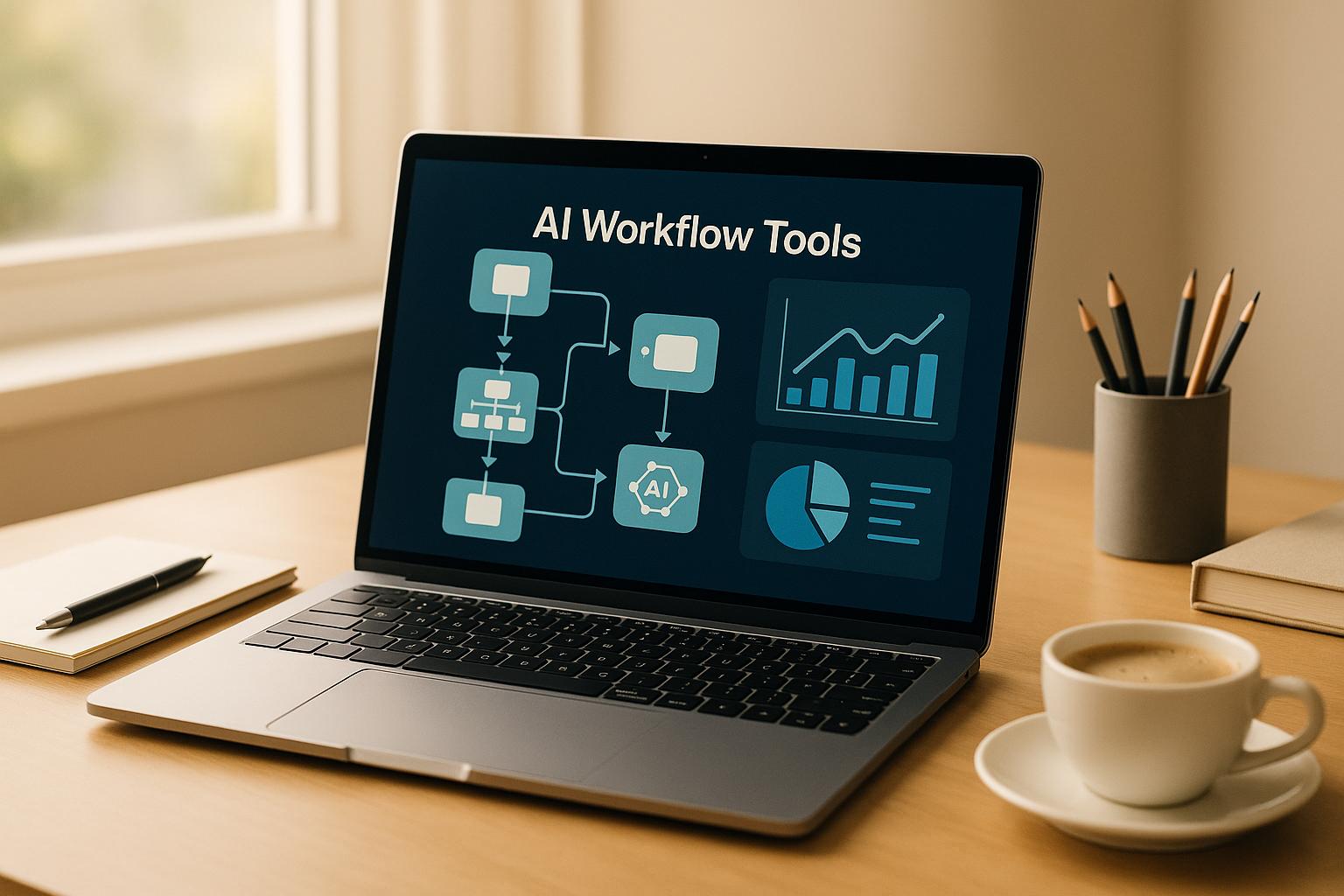
Les systèmes déconnectés et les flux de travail manuels sont une perte de temps et de ressources. Les outils de flux de travail basés sur l'IA résolvent ce problème en automatisant les processus et en intégrant des plateformes, les grands modèles de langage (LLM) ajoutant une intelligence contextuelle. En 2024, le marché du LLM d'entreprise a atteint 5,6 milliards de dollars, avec des gains de productivité de 40 % signalés par les utilisateurs. Cet article compare quatre outils de flux de travail basés sur l'IA : Prompts.ai, Zapier, Flux d'air Apache, et Plateau .io - en fonction de leurs points forts, de leurs limites et des meilleurs cas d'utilisation.
Choisissez en fonction des besoins, des compétences techniques et du budget de votre équipe. Chaque outil offre des avantages uniques adaptés à des flux de travail spécifiques, de l'automatisation des petites entreprises à l'orchestration de l'IA en entreprise.
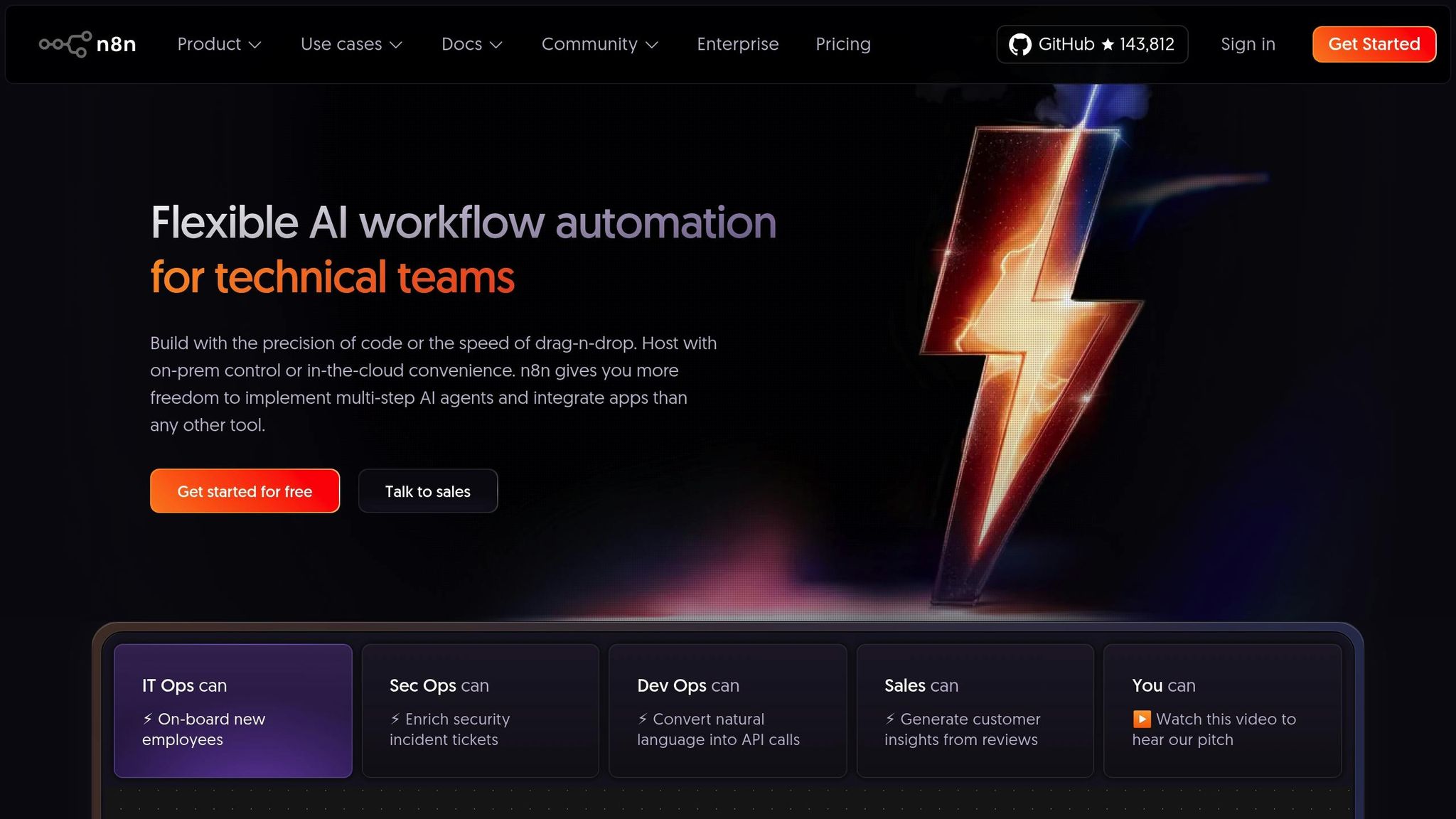
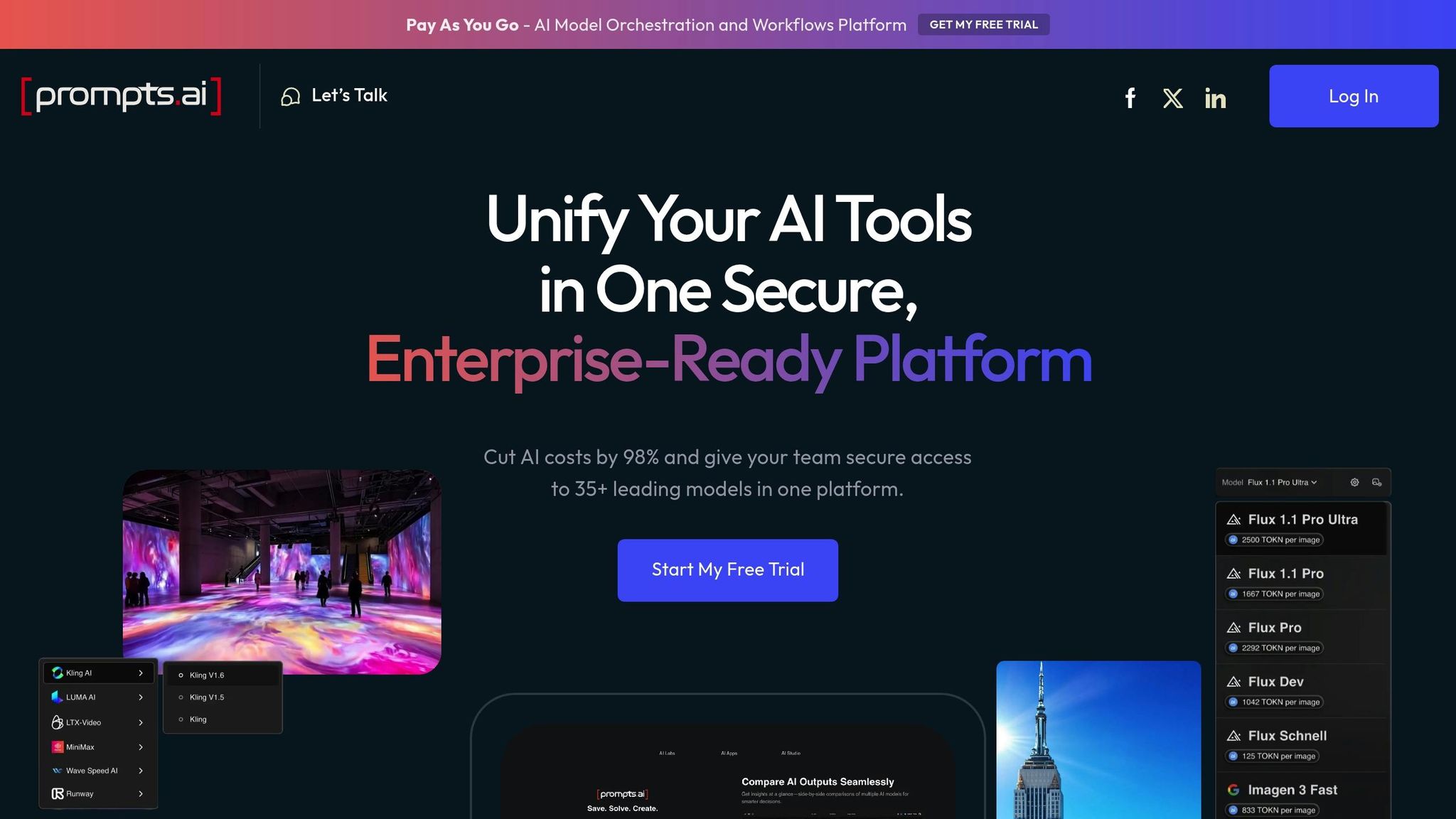
Dans le paysage en constante évolution des flux de travail d'IA, Prompts.ai redéfinit la façon dont les entreprises gèrent et optimisent leurs opérations d'IA, en proposant un moyen plus intelligent et plus efficace de gérer la gestion avancée des modèles.
Prompts.ai sert de plateforme d'orchestration d'IA de niveau entreprise, conçu pour rationaliser les opérations, réduire les coûts et garantir une supervision adéquate. Il répond à la demande croissante de flux de travail d'IA intégrés et intelligents. Contrairement aux outils traditionnels qui se concentrent principalement sur la connexion d'applications, Prompts.ai se concentre sur Gestion et optimisation des modèles d'IA, ce qui la distingue dans l'industrie.
Prompts.ai regroupe plus de 35 modèles de langage de premier plan, dont GPT-5, Claude, Lama, Gémeaux, Flux Pro et Kling - dans une interface unique et unifiée. Cela élimine les tracas liés à la jonglerie entre plusieurs abonnements et outils.
L'une de ses caractéristiques les plus remarquables est sa capacité à exécuter comparaisons de performances côte à côte. Cela permet aux utilisateurs de tester des instructions identiques sur différents modèles, ce qui les aide à affiner les performances et les coûts. De plus, la plateforme propose « Des gains de temps », qui sont des flux de travail rapides conçus par des experts qui intègrent les meilleures pratiques. Ces flux de travail permettent aux équipes de démarrer sans avoir à repartir de zéro.
Gérer les coûts liés à l'adoption de l'IA peut souvent donner l'impression de naviguer dans des eaux inexplorées. Prompts.ai simplifie cela grâce à une couche FinOps intégrée qui suit l'utilisation des jetons et relie directement les dépenses aux résultats commerciaux. C'est système de crédit TOKN à paiement à l'utilisation permet aux organisations de réduire leurs coûts jusqu'à 98 %, en fournissant un cadre financier clair et prévisible.
Prompts.ai est conçu pour évoluer avec votre organisation. L'ajout de modèles, d'utilisateurs ou d'équipes ne prend que quelques minutes. La plateforme propose également des programmes de certification Prompt Engineer et des flux de travail partagés, permettant aux équipes de développer une expertise interne et d'adopter les meilleures pratiques de manière fluide.
La sécurité des données est une préoccupation majeure pour les entreprises, et Prompts.ai y répond de manière frontale. Il fournit des fonctionnalités de gouvernance robustes et des pistes d'audit complètes, garantissant que les données sensibles restent au sein de l'organisation tout en tirant parti des capacités d'IA de pointe. Cela en fait une solution idéale pour les entreprises qui hésitent à adopter pleinement l'IA pour des raisons de sécurité.
Prompts.ai apparaît comme un outil puissant pour les organisations qui cherchent à centraliser leurs opérations d'IA. Il assure le contrôle des coûts, la gouvernance et l'évolutivité, permettant aux équipes d'étendre leurs initiatives d'IA en toute confiance et efficacité dans divers cas d'utilisation.
Zapier simplifie l'automatisation en connectant plus de 8 000 applications et en exécutant des centaines de millions de tâches, permettant ainsi aux utilisateurs sans expertise en matière de codage de rationaliser des processus complexes.
La caractéristique la plus remarquable de Zapier est son vaste écosystème d'intégrations. Avec la prise en charge de plus de 8 000 applications et services, il est à la pointe en matière de connectivité parmi les outils de flux de travail. Cela inclut l'accès à plus de 450 outils spécifiques à l'IA et à plus de 30 000 actions dans sa bibliothèque d'applications.
Le protocole MCP (Model Context Protocol) de la plateforme relie des plateformes d'IA telles que Chat GPT et Claude grâce au vaste réseau d'intégration de Zapier, permettant à ces outils d'effectuer des tâches pratiques. En outre, les webhooks personnalisés permettent de se connecter à pratiquement tous les services dotés d'une API, ce qui garantit que même les applications de niche ou propriétaires peuvent être intégrées de manière fluide dans les flux de travail.
S'appuyant sur ce vaste réseau, Zapier intègre des technologies avancées Capacités d'orchestration de l'IA pour améliorer encore l'automatisation.
Les outils d'orchestration de l'IA de Zapier rationalisent les flux de travail en intégrant les principaux modèles d'IA tels que ChatGPT, Claude et Gemini directement dans les automatisations, sans avoir besoin de clés d'API distinctes.
Les agents Zapier agissent comme des assistants autonomes, gérant des tâches en plusieurs étapes sur des milliers d'applications, accédant aux données de l'entreprise en temps réel et prenant des décisions éclairées. Ces agents peuvent être intégrés dans des Zaps existants, ajoutant ainsi une prise de décision intelligente aux processus automatisés.
Un exemple notable en est télécommande, qui a utilisé l'orchestration IA de Zapier pour classer et hiérarchiser automatiquement les tickets du service d'assistance. Cela a permis de résoudre 28 % des tickets sans intervention humaine, soit un gain de plus de 600 heures par mois.
« Il ne s'agit pas simplement d'en faire plus. Il s'agit de le faire mieux, plus rapidement et avec moins de ressources. » - Jason Alvarez-Cohen, PDG de Popl
Nous allons ensuite explorer l'évolutivité, la structure de coûts et les fonctionnalités de sécurité de Zapier.
Zapier s'adapte à des besoins croissants sans nécessiter de développement personnalisé. Sa fonctionnalité Copilot utilise le langage naturel pour identifier les opportunités d'automatisation et simplifier la création de flux de travail, répondant ainsi à ce que Chris Geoghegan, vice-président des produits chez Zapier, qualifie de « surcharge d'outils d'IA ».
« Les organisations sont confrontées à une surcharge d'outils d'IA, tout comme elles ont été confrontées à une surcharge logicielle il y a dix ans. Copilot ne vous aide pas seulement à créer des automatisations ; il vous aide à trouver des opportunités dont vous ignoriez l'existence. Nous rendons la puissante orchestration de l'IA aussi simple que d'avoir une conversation, que vous soyez un utilisateur professionnel qui gagne en productivité ou une équipe informatique qui soutient l'ensemble de l'entreprise. » - Chris Geoghegan, vice-président des produits, Zapier
La plateforme propose également des outils tels que Canvas pour visualiser les flux de travail, des actions personnalisées pour les fonctionnalités spécifiques à l'équipe et des étapes de code qui génèrent automatiquement du JavaScript ou du Python à partir d'entrées en langage clair. Zapier a récemment inclus sa base de données Tables et ses outils de création de formulaires Interfaces dans tous les niveaux d'abonnement, éliminant ainsi le coût supplémentaire de 20 dollars par mois.
Cette flexibilité s'étend à sa structure de prix claire.
Le modèle de tarification basé sur les tâches de Zapier garantit une visibilité claire des coûts d'utilisation de l'IA, les appels avancés étant considérés comme deux tâches.
Par exemple, Campagne active a tiré parti de l'orchestration de l'IA de Zapier pour remanier son processus d'intégration des clients, en augmentant de 440 % la participation aux webinaires, en réduisant de 15 % le taux de désabonnement sur 90 jours et en doublant le taux d'adoption des produits au cours des 30 premiers jours. De même, Popl a économisé 20 000 dollars par an en remplaçant une intégration coûteuse par une automatisation basée sur Zapier.
Zapier donne la priorité à la sécurité et détient les certifications SOC 2 Type II et SOC 3 délivrées par des auditeurs tiers. Les données sont chiffrées en transit avec TLS 1.2 et au repos à l'aide du cryptage AES-256.
Pour les organisations qui gèrent des données sensibles, Zapier propose des contrôles d'accès basés sur les rôles, une authentification unique via SAML, une liste d'adresses IP autorisées et une journalisation d'audit détaillée. La plateforme est conforme au cadre de confidentialité des données UE-États-Unis, à l'extension britannique et au cadre de confidentialité des données Suisse-États-Unis, garantissant des transferts de données internationaux sécurisés.
Les entreprises clientes bénéficient de la possibilité de se désinscrire automatiquement de la formation sur les modèles d'IA, tandis que les autres peuvent facilement demander leur désinscription. Des périodes de conservation des données personnalisées allant de 7 à 30 jours sont également disponibles pour les utilisateurs des forfaits Company et Enterprise.
« Les clients nous font confiance pour assurer la sécurité de leurs données. Je suis convaincu que Zapier gère ces données avec la plus grande sécurité. » - Connor Sheffield, responsable des opérations marketing et de l'automatisation, Zonos
Cependant, il est important de noter que Zapier ne prend pas en charge la conformité HIPAA pour les informations de santé protégées (PHI).
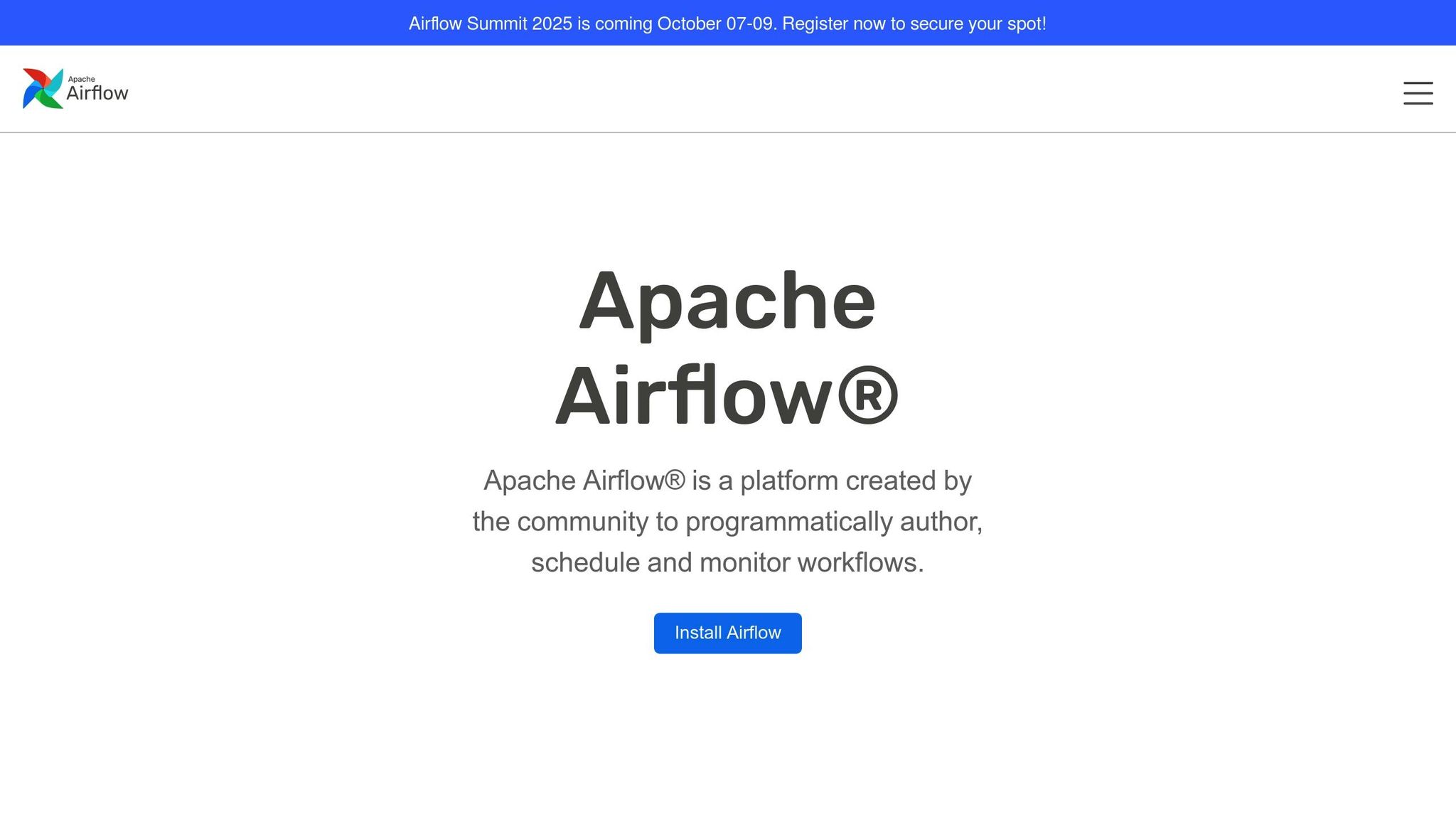
Apache Airflow est un plateforme open source conçue pour orchestrer des flux de travail d'IA complexes, y compris les LLMOP. Grâce aux contributions de plus de 3 000 développeurs et à son adoption par de nombreuses entreprises du Fortune 500, il est devenu la pierre angulaire des opérations d'IA des entreprises.
Construit sur un Framework natif Python, Airflow s'intègre parfaitement aux outils d'apprentissage automatique les plus populaires, aux services LLM (Large Language Model) et aux bases de données vectorielles. Il prend en charge les principales techniques LLMOP telles que l'ingénierie rapide, la génération augmentée de récupération (RAG) et le réglage précis de grands modèles de langage.
Le lancement de Airflow 3.0 en avril 2025 a marqué une mise à niveau significative : la première version majeure en quatre ans. Cette version a introduit un système de planification piloté par les événements, permettant le traitement de l'IA en temps réel et allant au-delà des flux de travail traditionnels basés sur des lots. Cette innovation favorise une automatisation réactive et intelligente.
« Pour moi, Airflow 3 marque un nouveau départ, c'est la base d'un ensemble de fonctionnalités bien plus étendu. Une refonte quasi complète répondant aux besoins des entreprises en matière de performances critiques. » - Vikram Koka, membre d'Apache Airflow PMC et directeur de la stratégie, astronome
Un exemple remarquable des capacités d'Airflow est « Demandez à Astro » de l'astronome, une référence publique pour Retrieval Augmented Generation. Ce système automatise les pipelines RAG en intégrant et en analysant les données des articles de presse afin de fournir des conseils commerciaux. Il met en évidence la capacité d'Airflow à alimenter les applications d'IA conversationnelle, ce qui le distingue des plateformes plus traditionnelles.
Airflow excelle également dans la gestion systèmes d'IA composés, où plusieurs modèles collaborent pour réaliser des tâches complexes. Contrairement à l'IA agentique, cette approche repose sur des flux de travail prédéfinis, offrant une prévisibilité et une fiabilité accrues pour les applications métier.
Flux d'air architecture modulaire s'appuie sur un système de file d'attente de messages pour coordonner les travailleurs, ce qui lui permet de gérer des millions, voire des milliards, de tâches. ShopifyL'énorme environnement Airflow en est un excellent exemple, qui gère plus de 10 000 DAG (graphes acycliques dirigés), plus de 400 tâches simultanées et plus de 150 000 courses quotidiennes.
La personnalisation est un autre point fort. Avec définition du flux de travail programmatique en Python, les utilisateurs peuvent créer des pipelines dynamiques adaptés à leurs besoins spécifiques. Les opérateurs et extensions personnalisés améliorent encore la flexibilité, en facilitant l'adaptation des flux de travail à des environnements opérationnels uniques.
L'architecture d'Airflow 3.0 apporte des améliorations importantes. En isolant le processeur DAG du planificateur, il améliore la sécurité, les performances et l'évolutivité. La nouvelle interface d'exécution des tâches (API de tâches) améliore la portabilité du code, permettant aux tâches de s'exécuter dans Airflow ou sous forme de scripts Python indépendants.
Pour les flux de travail pilotés par l'IA, le conception centrée sur les actifs rationalise la création de pipelines. Le @asset decorator permet de générer automatiquement des DAG et des tâches, tandis qu'Asset Watchers prend en charge la planification pilotée par les événements en déclenchant des flux de travail basés sur des événements externes, tels que ceux des services AWS.
« Nous sommes impatients de passer à Airflow 3 et à ses améliorations en matière de planification, d'observabilité et de traçabilité des données pilotées par les événements. Comme nous comptons déjà sur Airflow pour gérer nos pipelines critiques d'IA et de ML, l'efficacité et la fiabilité accrues d'Airflow 3 contribueront à renforcer la confiance et la résilience de ces produits de données au sein de l'ensemble de notre organisation. » - Oliver Dykstra, ingénieur des données complet, Texas Rangers Baseball Club
En tant que solution open source, Apache Airflow élimine les frais de licence, offrant ainsi une transparence totale des coûts. Les entreprises ne paient que pour l'infrastructure qu'elles utilisent, ce qui en fait un choix très économique pour les flux de travail d'IA à grande échelle.
Pour ceux qui préfèrent les options gérées, Flux de travail gérés par Amazon pour Apache Airflow (MAAA) propose un modèle de paiement à l'utilisation sans frais initiaux. Cette flexibilité permet d'adapter les coûts directement à l'utilisation.
Un exemple notable d'adoption par les entreprises est le Texas Rangers Baseball Club, qui utilise Airflow sur la plateforme Astro d'Astronomer comme centre central pour le développement des joueurs, les contrats, les analyses et les données de jeu. Leur mise à niveau prévue vers Airflow 3 souligne sa valeur pour les flux de travail IA/ML critiques.
Airflow 3.0 présente mesures de sécurité renforcées en découplant l'exécution des tâches des autres composants du système. Cela réduit les surfaces d'attaque et améliore la gouvernance des données en garantissant que les tâches communiquent avec un serveur d'API pour les mises à jour de statut plutôt que d'écrire directement dans la base de données de métadonnées.
La plateforme prend également en charge Exécution à distance, qui garantit que les données sensibles restent dans des environnements sécurisés pendant que les tâches sont exécutées localement. Cette conception est conforme à des réglementations telles que HIPAA, SOC 2 et GDPR, en utilisant une architecture Zero Trust qui élimine les connexions entrantes pour les charges de travail sensibles.
« Airflow 3 dissocie l'exécution des tâches des autres composants du système Airflow, réduisant ainsi considérablement les surfaces d'attaque et améliorant la gouvernance des données. » - Astronome
Des services gérés tels que Astro renforcez encore la sécurité grâce à des fonctionnalités telles que l'identité des charges de travail gérée par le client, la gestion des clés de chiffrement, les clouds privés virtuels (VPC) et la surveillance continue avec détection des menaces en temps réel. Les certifications d'Astro, notamment SOC 2 et ISO 27001, valident sa conformité aux normes de l'industrie.
Pour les organisations qui gèrent des données hautement sensibles, Agents d'exécution à distance fournir une solution d'orchestration sécurisée. Ces agents garantissent que les données sensibles ne quittent jamais l'infrastructure locale, en conservant uniquement les connexions cryptées sortantes. Chaque tâche est authentifiée à l'aide d'identités solides, ce qui garantit une conformité et une sécurité robustes. Nous verrons ensuite comment Tray.io aborde l'orchestration évolutive des flux de travail basés sur l'IA.
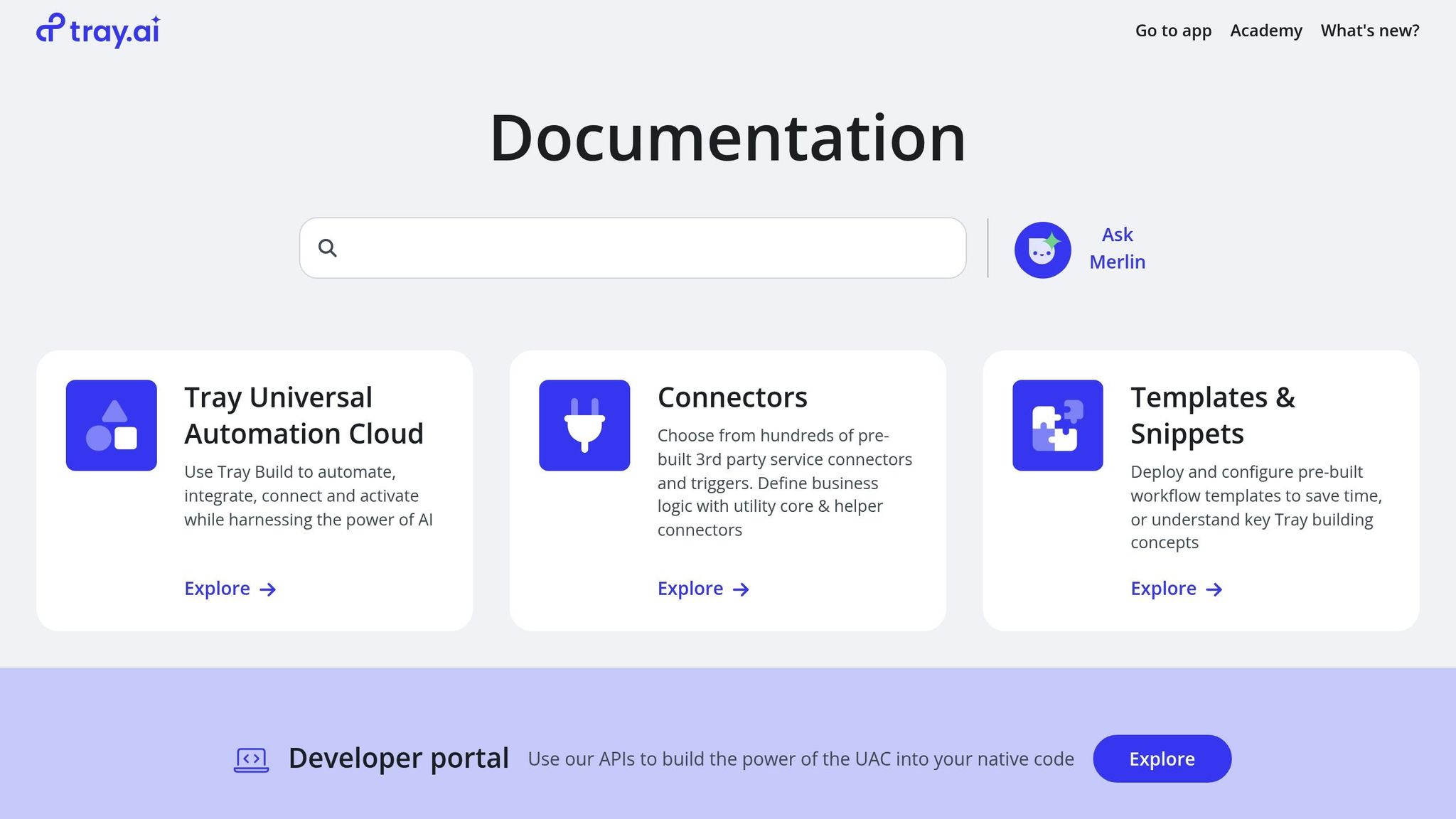
Lors de l'évaluation d'outils de flux de travail d'IA de premier plan, Tray.io se distingue par ses puissantes capacités d'intégration et d'orchestration de l'IA. Conçu comme une plateforme d'intégration en tant que service (iPaaS) prête à l'IA, Tray.io permet une automatisation et une gestion des flux de travail à l'échelle de l'entreprise. Son Universal Automation Cloud et Merlin Intelligence alimentent ses fonctionnalités robustes.
Tray.io excelle dans la connexion d'environnements basés sur le cloud, sur site et inter-écosystèmes grâce à des centaines de connecteurs et de recettes prédéfinis. Ces outils simplifient la synchronisation et la transformation des données en proposant des aides visuelles à faible code pour des tâches telles que l'enrichissement des données, les recherches, la dénormalisation et l'agrégation. Il prend également en charge le traitement CSV avancé pour l'importation, l'exportation, la jonction, le tri et la mise à jour de fichiers. Pour les systèmes existants, Tray.io garantit une intégration bidirectionnelle sécurisée via FTP/SFTP.
Par exemple, GitHub utilise Tray.io pour synchroniser les données clients afin d'améliorer l'engagement et l'attribution, tandis que Texte a rationalisé ses processus d'intégration grâce à une surveillance intégrée et à des tableaux de bord en temps réel. La plateforme se connecte également de manière fluide aux principaux entrepôts de données cloud tels que Amazon Redshift, Flocon de neige, Google BigQuery, et Databricks, et s'intègre à des outils d'analyse tels que Power BI et Tableau. Connexions populaires avec des plateformes telles que Salesforce, Slack, NetSuite, JIRA, Zendesk, HubSpot, et IA ouverte démontre une fois de plus sa polyvalence. Un client a partagé :
« Nous avons quadruplé notre vitesse de mise en œuvre de l'intégration. Plus d'intégrations se traduisent par des clients plus satisfaits qui peuvent réagir encore plus rapidement aux vulnérabilités de cybersécurité. »
Cette connectivité étendue constitue une base solide pour les capacités avancées d'orchestration de l'IA de Tray.io.
Tray.io introduit une approche transformatrice des opérations pilotées par l'IA avec son Merlin Agent Builder. S'appuyant sur un cadre de génération augmentée de récupération (RAG), la plateforme garantit que les grands modèles de langage (LLM) sont ancrés dans sa base de connaissances, ce qui permet de maintenir des résultats précis et à jour. Une caractéristique remarquable est son approche Bring-your-own-LLM (BYOLLM), qui prend en charge plusieurs LLM de fournisseurs tels qu'OpenAI (GPT-4), Anthropique (Claude), Google (Gémeaux), Socle rocheux, et Azure.
Le Merlin Agent Builder permet de créer rapidement des flux de travail alimentés par l'IA, tels que des réponses automatisées aux tickets. Il inclut également des sources de données intelligentes, qui permettent de synchroniser en un clic des données structurées et non structurées, en les préparant et en les vectorisant automatiquement pour une utilisation par l'IA. Le système de mémoire de la plateforme, qui combine des fonctionnalités à court et à long terme avec des fenêtres contextuelles coulissantes, permet aux agents de maintenir le contexte lors d'interactions complexes en plusieurs étapes.
Ces fonctionnalités d'IA s'intègrent parfaitement à l'infrastructure évolutive de Tray.io.
Tray.io est conçu pour répondre aux demandes à l'échelle de l'entreprise, en traitant des téraoctets de données et des milliards de tâches à une vitesse inférieure à la seconde. Son cadre de développement composable permet aux équipes de créer des composants réutilisables, extensibles avec JavaScript ou Python, tandis que des modèles prédéfinis permettent d'accélérer les projets d'automatisation. La plateforme comprend également des outils de gouvernance d'entreprise, permettant aux utilisateurs professionnels et aux développeurs de garder le contrôle tout en développant leurs opérations. Tray.io a reçu de nombreux éloges de la part des clients, les utilisateurs lui ayant attribué une note globale de 4,9/5, soulignant ainsi sa capacité à passer de simples intégrations point à point à des flux de travail complexes avec une logique conditionnelle.
Tray.io fonctionne selon un modèle de tarification basé sur un abonnement, à partir de 500$ par mois, avec une évolutivité basée sur l'utilisation pour plus de flexibilité. Pour les entreprises, il propose un modèle de tarification basé sur la capacité adapté à leurs besoins. Bien que cette approche permette la personnalisation, elle peut entraîner des coûts moins prévisibles par rapport aux alternatives à frais fixes. Les utilisateurs ont attribué à Tray.io une note de 4,7/5 en termes de rapport qualité-prix, en particulier auprès des grandes entreprises et des moyennes entreprises ayant des exigences d'automatisation importantes [50,51].
Tray.io a été reconnu comme un visionnaire dans le Gartner® Magic Quadrant™ 2025 pour iPaaS et a obtenu la meilleure note pour le soutien à la mise en œuvre de l'IA lors de l'évaluation des capacités critiques réalisée par Gartner en mai 2025. L'Enterprise Core de la plateforme comprend des cadres de gouvernance complets et des tableaux de bord de surveillance en temps réel qui offrent une visibilité claire sur les performances et la sécurité. Comme le souligne Rich Waldron, cofondateur et PDG de Tray.io :
« La pièce maîtresse lorsqu'il s'agit de réfléchir au déploiement de l'IA au sein de votre organisation est en fait votre fournisseur iPaaS ».
Sur la base des analyses des plateformes ci-dessus, voici un aperçu des points forts et des limites de chaque outil.
Prompts.ai simplifie les flux de travail d'IA en centralisant l'accès à plus de 35 modèles de pointe au sein d'une interface unifiée et sécurisée. Son système de crédit TOKN par répartition permet de réduire les coûts jusqu'à 98 %, tandis que les comparaisons de modèles côte à côte simplifient la prise de décision pour les ingénieurs et les équipes créatives. Cependant, étant donné qu'elle se concentre principalement sur l'orchestration de l'IA, elle n'offre peut-être pas la même profondeur pour les tâches d'automatisation commerciale traditionnelles.
Zapier se connecte à plus de 8 000 applications via une interface glisser-déposer conviviale et sans code, ce qui en fait la préférée des utilisateurs non techniques. Bien qu'il excelle en matière d'accessibilité, sa tarification basée sur les tâches peut devenir imprévisible à mesure que l'utilisation évolue, et les automatisations en plusieurs étapes peuvent parfois subir des retards.
Flux d'air Apache offre une personnalisation et une évolutivité inégalées, donnant aux équipes de développement un contrôle total sur la logique des flux de travail via Python. Il est idéal pour le traitement des données à l'échelle de l'entreprise, grâce à l'exécution distribuée des tâches et à un riche écosystème de plugins. Cependant, sa complexité technique et l'absence d'interface visuelle peuvent constituer des obstacles pour les utilisateurs non techniques, qui doivent souvent compter sur le soutien de la communauté plutôt que sur un service client dédié.
Plateau .io offre des performances de niveau professionnel avec des fonctionnalités d'IA avancées grâce à son Merlin Agent Builder. Bien qu'il soit puissant, sa tarification basée sur l'utilisation peut être imprévisible et ses fonctionnalités avancées nécessitent souvent une expertise technique.
Le tableau ci-dessous résume ces points forts et ces limites pour faciliter la comparaison :
Le marché de l'automatisation des flux de travail devrait atteindre environ 87,7 milliards de dollars d'ici 2032, près de 75 % des développeurs utilisant déjà ou prévoyant d'intégrer des outils d'IA dans leurs projets. Ces compromis soulignent l'importance de faire correspondre les capacités des outils aux besoins spécifiques de l'entreprise.
Le choix du bon outil dépend de vos priorités commerciales, de votre expertise technique et de votre budget. Sur la base des informations de la plateforme partagées précédemment, voici des suggestions personnalisées pour vous aider à répondre à vos besoins avec les solutions les plus adaptées.
Pour les équipes centrées sur l'IA et axées sur la rentabilité
Prompts.ai se démarque pour les équipes qui souhaitent rationaliser l'orchestration des modèles d'IA tout en maîtrisant les coûts. Avec l'accès à plus de 35 modèles de pointe et à un système de crédit TOKN flexible avec paiement à l'utilisation, c'est un choix judicieux pour les agences de création, les laboratoires de recherche et les entreprises qui cherchent à consolider leurs outils sans compromettre la sécurité.
Pour les petites entreprises ayant des connaissances techniques limitées
Les petites entreprises devraient se tourner vers des outils proposant des interfaces sans code et des niveaux gratuits généreux. Ces fonctionnalités facilitent la mise en œuvre de l'automatisation et permettent un retour sur investissement rapide. Zapier, avec son générateur de flux de travail par glisser-déposer et ses vastes capacités d'intégration, est idéal pour les équipes non techniques qui souhaitent simplifier les processus.
Pour les équipes techniques qui recherchent un contrôle total
Apache Airflow convient parfaitement aux équipes de développement qui gèrent des pipelines d'IA et des flux de données complexes. Son framework basé sur Python permet une personnalisation et une évolutivité approfondies. Étant open source, il élimine les frais de licence, offrant une solution rentable pour les opérations au niveau de l'entreprise qui exigent une flexibilité maximale.
Pour les grandes entreprises
Les entreprises devraient se concentrer sur le coût total de possession plutôt que sur les simples frais d'abonnement. Les investissements dans l'IA génèrent souvent des rendements importants, de nombreuses grandes entreprises enregistrant un retour sur investissement compris entre 300 et 600 % en trois ans. Tray.io est spécialement conçu pour les déploiements à l'échelle de l'entreprise, mais sa complexité peut nécessiter une expertise technique dédiée pour exploiter tout son potentiel.
Options économiques
Pour les équipes dont les budgets sont serrés, des outils auto-hébergés tels qu'Apache Airflow ou des plateformes proposant des niveaux gratuits robustes peuvent fournir des fonctionnalités d'automatisation essentielles sans encourir de coûts mensuels élevés.
Sélection stratégique et mise en œuvre
Commencez par identifier les tâches les plus chronophages et choisissez des outils qui s'intègrent parfaitement à vos logiciels existants. Testez 2 à 3 solutions dans le cadre de projets pilotes pour comprendre leur impact. Optez pour des plateformes qui non seulement automatisent les processus, mais améliorent également l'ensemble de votre écosystème d'IA. Le suivi du retour sur investissement est essentiel pour garantir que chaque intégration apporte des avantages mesurables. Alors que près de 80 % des petites entreprises prévoient d'adopter l'IA d'ici 2025, prendre une longueur d'avance pourrait leur apporter un avantage concurrentiel significatif.
Les outils de flux de travail basés sur l'IA, tels que Prompts.ai, transforment le mode de fonctionnement des entreprises en automatisation des tâches répétitives, simplifiant les flux de travail complexes et permettant une prise de décision plus rapide et basée sur les données. Cela réduit non seulement les efforts manuels, mais permet également aux équipes de consacrer plus de temps à des activités stratégiques à fort impact, ce qui entraîne une augmentation notable de la productivité.
En matière de gestion des coûts, ces outils s'avèrent changer la donne. En optimisant les processus et en remédiant aux problèmes d'efficacité, les entreprises peuvent réduire leurs dépenses opérationnelles de manière significative. En fait, de nombreuses organisations ont enregistré des économies de 20 % à 30 % grâce à l'automatisation, qui réduit les erreurs et garantit une meilleure utilisation des ressources. En rationalisant les opérations et en améliorant l'efficacité globale, Prompts.ai aide les entreprises à accomplir davantage tout en utilisant moins de ressources.
Lors du choix d'un outil de flux de travail basé sur l'IA, il est essentiel de prendre en compte des facteurs tels que options d'intégration, facilité d'utilisation, évolutivité, et dans quelle mesure l'outil répond à vos besoins en matière de flux de travail. Par exemple, des outils tels qu'Apache Airflow sont idéaux pour gérer des flux de travail complexes et personnalisés en raison de leur flexibilité, tandis que les plateformes telles que Zapier sont conçues pour une automatisation simple et rapide des applications SaaS.
Tenez compte de la situation de votre équipe expertise technique et l'étendue de l'automatisation requise. Les outils d'entreprise sont souvent dotés de fonctionnalités avancées et d'une capacité d'évolutivité, tandis que les plateformes telles que Prompts.ai se concentrent sur la simplification des flux de travail pilotés par l'IA grâce à des fonctionnalités d'intégration et d'automatisation fluides. Votre décision doit refléter vos objectifs spécifiques, qu'il s'agisse de gérer des pipelines de données à grande échelle ou d'automatiser efficacement les processus quotidiens.
La sécurité et la conformité ne sont pas négociables pour les outils de flux de travail d'IA, en particulier pour les entreprises qui gèrent des informations sensibles. Les principales caractéristiques incluent généralement chiffrement, contrôles d'accès, journaux d'audit, et le respect de réglementations telles que GDPR, HIPAA, et normes ISO. Ces mesures protègent non seulement les données, mais garantissent également l'alignement de la réglementation et renforcent la confiance dans les opérations pilotées par l'IA.
Cela dit, la robustesse des fonctionnalités de sécurité et de conformité peut varier considérablement d'une plateforme à l'autre. Certains outils avancés vont plus loin en fournissant surveillance en temps réel, rapports de conformité automatisés, et solutions de sécurité évolutives basées sur le cloud. Pour les entreprises, ces fonctionnalités sont essentielles pour protéger leurs flux de travail tout en garantissant leur conformité et leur efficacité opérationnelle.


